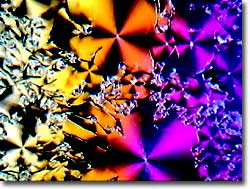Chemical Crystal Movie Gallery
Picolinic Acid Time Lapse Sequences
Picolinic acid is the body's prime natural chelator of the vital trace elements chromium, zinc, manganese, copper, iron, and molybdenum. Biosynthesized in the liver and kidneys from the amino acid tryptophan, and stored in the pancreas during digestion, picolinic acid is secreted into the intestine.

As an isomer of nicotinic acid, picolinic acid is a six-member cyclic compound which has a nitrogen atom in place of one of the carbon ring members, plus a carboxyl side chain. There are 6 carbon, 5 hydrogen, 1 nitrogen, and 2 oxygen atoms per molecule, and the compound's molecular weight is 123.1. Allowed to cool from a melt, slowly-recrystallizing picolinic acid forms beautiful dendritic, needle-like crystals.
In the process of chelation, picolinic acid (PA), known also as 2-pyridine carboxylic acid to biochemists, is able to attract a positively charged ion into its larger molecular structure and shield the charge so that the ion appears to be neutral or negatively charged. The chelated elements are able to pass through the polarized cellular membranes while the free ions are excluded. This chelation of certain trace elements by picolinic acid is thought to make them more readily available to the body as nutrients.
Among the evidence supporting breast-feeding of infants over the feeding of cow's milk or commercial formula is that picolinic acid is found at 30 times the concentration in a mother's milk compared to cow's milk, and about 300 times greater than in infant formula. Even though pasteurized cow's milk has twice as much zinc as mother's milk, much more zinc is absorbed by the baby that is nursing. Without the help of picolinic acid, many of the trace elements would simply pass through the gastrointestinal tract and not enter the circulatory system via the intestinal lining. Chromium picolinate is a very popular dietary supplement that may reduce body fat, increase lean muscle, and increase insulin sensitivity. Without binding of the trivalent chromium to the picolinic acid, it would not be as readily absorbed, and available to be utilized as an enzyme catalyst. In a similar product, vitamin companies market zinc bound to picolinic acid as a dietary supplement.
Herbicides have been derived from picolinic acid and include clopyralid and picloram. Known also as 3,6-dichloropyridine-2-carboxylic acid, the herbicide clopyralid, labeled for use on weeds and woody plants (including mesquite and thistle), is structured with 6 carbon, 3 hydrogen, 2 chlorine, 1 nitrogen, and 2 oxygen atoms per molecule. Picloram, the organic chemical 4-amino-3,5,6-trichloropyridine-2-carboxylic acid, and known to foresters, range managers, and highway departments as the trade product Tordon, is usually applied to cut tree stumps, as a potassium salt, to prevent resprouting. This herbicide includes an additional chlorine and nitrogen atom in its chemical formula, as compared to clopyralid.
Picolinic Acid Time Lapse Sequence #1 - This time-lapse sequence of 28 images begins with the crystallization of spherulites, and then progresses into formation of crystallites of a different texture.
Picolinic Acid Time Lapse Sequence #2 - Spherulites are initially formed, followed by crystallization of a more blocky-textured material that nearly obliterates the spherulitic forms as it occupies the entire viewfield in this sequence of 28 images.
Picolinic Acid Time Lapse Sequence #3 - A time-lapse sequence of 33 images illustrates the crystallization of both spherulites and a later-forming non-spherulitic crystal type resulting in a spectrum of birefringence colors.
Picolinic Acid Time Lapse Sequence #4 - Somewhat angular spherulites form and advance during growth into the viewfield, accompanied by the formation of another finer-textured crystalline phase in a sequence of 35 time-lapse images.
Contributing Authors
Omar Alvarado, Thomas J. Fellers and Michael W. Davidson - National High Magnetic Field Laboratory, 1800 East Paul Dirac Dr., The Florida State University, Tallahassee, Florida, 32310.
BACK TO THE CHEMICAL CRYSTAL MOVIE GALLERY
BACK TO THE DIGITAL IMAGE GALLERIES
Questions or comments? Send us an email.
© 1995-2025 by Michael W. Davidson and The Florida State University. All Rights Reserved. No images, graphics, software, scripts, or applets may be reproduced or used in any manner without permission from the copyright holders. Use of this website means you agree to all of the Legal Terms and Conditions set forth by the owners.
This website is maintained by our
Graphics & Web Programming Team
in collaboration with Optical Microscopy at the
National High Magnetic Field Laboratory.
Last Modification Friday, Nov 13, 2015 at 01:19 PM
Access Count Since September 17, 2002: 18741
Visit the website of our partner in introductory microscopy education:
|
|
